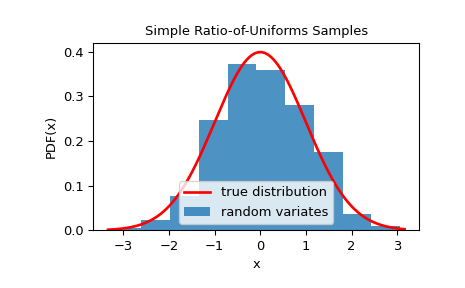SimpleRatioUniforms#
- class scipy.stats.sampling.SimpleRatioUniforms(dist, *, mode=None, pdf_area=1, domain=None, cdf_at_mode=None, random_state=None)#
Simple Ratio-of-Uniforms (SROU) Method.
SROU is based on the ratio-of-uniforms method that uses universal inequalities for constructing a (universal) bounding rectangle. It works for T-concave distributions with
T(x) = -1/sqrt(x). The main advantage of the method is a fast setup. This can be beneficial if one repeatedly needs to generate small to moderate samples of a distribution with different shape parameters. In such a situation, the setup step ofNumericalInverseHermiteorNumericalInversePolynomialwill lead to poor performance.- Parameters:
- distobject
An instance of a class with
pdfmethod.pdf: PDF of the distribution. The signature of the PDF is expected to be:def pdf(self, x: float) -> float. i.e. the PDF should accept a Python float and return a Python float. It doesn’t need to integrate to 1 i.e. the PDF doesn’t need to be normalized. If not normalized, pdf_area should be set to the area under the PDF.
- modefloat, optional
(Exact) Mode of the distribution. When the mode is
None, a slow numerical routine is used to approximate it. Default isNone.- pdf_areafloat, optional
Area under the PDF. Optionally, an upper bound to the area under the PDF can be passed at the cost of increased rejection constant. Default is 1.
- domainlist or tuple of length 2, optional
The support of the distribution. Default is
None. WhenNone:If a
supportmethod is provided by the distribution object dist, it is used to set the domain of the distribution.Otherwise the support is assumed to be \((-\infty, \infty)\).
- cdf_at_modefloat, optional
CDF at the mode. It can be given to increase the performance of the algorithm. The rejection constant is halfed when CDF at mode is given. Default is
None.- random_state{None, int,
numpy.random.Generator, numpy.random.RandomState}, optionalA NumPy random number generator or seed for the underlying NumPy random number generator used to generate the stream of uniform random numbers. If random_state is None (or np.random), the
numpy.random.RandomStatesingleton is used. If random_state is an int, a newRandomStateinstance is used, seeded with random_state. If random_state is already aGeneratororRandomStateinstance then that instance is used.
Methods
rvs([size, random_state])Sample from the distribution.
set_random_state([random_state])Set the underlying uniform random number generator.
References
[1]UNU.RAN reference manual, Section 5.3.16, “SROU - Simple Ratio-of-Uniforms method”, http://statmath.wu.ac.at/software/unuran/doc/unuran.html#SROU
[2]Leydold, Josef. “A simple universal generator for continuous and discrete univariate T-concave distributions.” ACM Transactions on Mathematical Software (TOMS) 27.1 (2001): 66-82
[3]Leydold, Josef. “Short universal generators via generalized ratio-of-uniforms method.” Mathematics of Computation 72.243 (2003): 1453-1471
Examples
>>> from scipy.stats.sampling import SimpleRatioUniforms >>> import numpy as np
Suppose we have the normal distribution:
>>> class StdNorm: ... def pdf(self, x): ... return np.exp(-0.5 * x**2)
Notice that the PDF doesn’t integrate to 1. We can either pass the exact area under the PDF during initialization of the generator or an upper bound to the exact area under the PDF. Also, it is recommended to pass the mode of the distribution to speed up the setup:
>>> urng = np.random.default_rng() >>> dist = StdNorm() >>> rng = SimpleRatioUniforms(dist, mode=0, ... pdf_area=np.sqrt(2*np.pi), ... random_state=urng)
Now, we can use the
rvsmethod to generate samples from the distribution:>>> rvs = rng.rvs(10)
If the CDF at mode is available, it can be set to improve the performance of
rvs:>>> from scipy.stats import norm >>> rng = SimpleRatioUniforms(dist, mode=0, ... pdf_area=np.sqrt(2*np.pi), ... cdf_at_mode=norm.cdf(0), ... random_state=urng) >>> rvs = rng.rvs(1000)
We can check that the samples are from the given distribution by visualizing its histogram:
>>> import matplotlib.pyplot as plt >>> x = np.linspace(rvs.min()-0.1, rvs.max()+0.1, 1000) >>> fx = 1/np.sqrt(2*np.pi) * dist.pdf(x) >>> fig, ax = plt.subplots() >>> ax.plot(x, fx, 'r-', lw=2, label='true distribution') >>> ax.hist(rvs, bins=10, density=True, alpha=0.8, label='random variates') >>> ax.set_xlabel('x') >>> ax.set_ylabel('PDF(x)') >>> ax.set_title('Simple Ratio-of-Uniforms Samples') >>> ax.legend() >>> plt.show()
